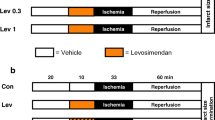Summary
In the isolated working rat heart, the damaging effect of 0.05–0.06 μM Carbonylcyanide-p-trifluoro-methoxyphenylhydrazone (FCCP) was reversible within 20 sec by perfusion with fresh buffer. Cysteine 3 mM restored the aortic flow to the initial value within an additional 15–20 sec. Thereafter, the FCCP effect became irreversible due to a progressive structural membrane change. The structural change by FCCP is probably brought about by ‘internalization’ of polar groups (R-SH; R−NH3 +) of the mitochondrial (and other) membrane.
Similar content being viewed by others
References
Bereiter-Hahn J (1976) Dimethylaminostyrylmethylpyridiniumiodine (DASPMI) as a fluorescent probe for mitochondria in situ. Biochim Biophys Acta 423:1–14
Drobnica L, Sturdik E (1979) The reaction of carbonylcyanidephenylhydrazones with thiols, Biochem Biophys Acta 585:462–476.
Foucher B, Gaudemer Y (1971), Specification of SH-groups in the mitochondrial energy coupling system, revealed by measurements of14C ethacrynate incorporation into rat liver mitochondria. FEBS Letters 13:95–97
Heil BM, Bereiter-Hahn J, Zimmer G (1982) NADH, flavoprotein and 2-(4-(Dimethylamino)styryl)-1-methyl-pyridinium Iodide (DASPMI) fluorescence at the surface of the isolated working rat heart. Z Physiol Chem 363:912
Heytler PG (1963) Uncoupling of oxidative phosphorylation by carbonylcyanide phenylhydrazones. I. Some characteristics of m-Cl-CCP action on mitochondria and chloroplasts. Biochemistry 2:357–361
Heytler PG (1979) Uncouplers of oxidative phosphorylation, in Methods in Enzymology, vol LV (Fleischer S, Packer L) Academic Press, New York San Francisco London pp 462–472
Hobson Mills W, Jackson Porn W (1922), 2p Dimethylstyrylpyridinium-methiodide, a new photographic sensitizer. J Chem Soc 57:946–947
Krebs HA, Henseleit K (1932) Untersuchungen über die Harnstoffbildung im Tierkörper. Z Physiol Chem 210:33–66
Kyogoku Y, Yoshikawa K, Terada H (1980) Hydration water in mitochondrial suspensions. In: Pullmann B, Yagi K (eds) Water and metal cations in biological systems. Japan Scientific Societies Press, Tokyo, pp 129–134
Langendorff O (1895) Untersuchungen am lebenden Säugetierherzen. Arch Ges Physiol 61:291–332
Lochner A, Kotze JCN, Benade AJS, Gevers W (1978) Mitochondrial oxidative phosphorylation in low-flow hypoxia: Role of free fatty acids. J Mol Cell Cardiol 10:857–875
Lochner A, Kotze JCN, Gevers W, Benade AJS (1979) Substrate effects on mitochondrial function and tissue lipids in low-flow hypoxia of isolated perfused rat hearts. Basic Res Cardiol 74:303–312
Manella CA, Parsons DF (1977) Uncoupler induced changes in mitochondrial structure detected by small angle X-ray scattering. Biochim Biophys Acta 460:375.
Neely JR, Liebermeister H, Battersby EJ, Morgan HE (1967) Effect of pressure development on oxygen consumption by isolated rat heart. Amer J Physiol 212:804–814
Philips AP (1947) Condensation of aromatic aldehydes with α-Picoline methiodide. Organ Chem 12:333–341
Sabadie-Pialoux N, Gautheron DC (1971) Free SH variations during ATP synthesis by oxidative phosphorylation in heart muscle mitochondria. Biochim Biophys Acta 234:9–15
Schapendonk HCM, Hemrika-Wagner AM, Theuvenet APR, Wong Fong Sang HW, Vredenberg WJR, Kraayenhof R (1980) Energy dependent changes of the electrokinetic properties of chloroplasts. Biochemistry 19:1922
Shiuan D, Tu SI (1978) Fluorescent labeling of mitoplast membrane, effect of oxidative Phosphorylation uncouplers. Biochemistry 17:2249–2252
Sungchul J, Nishiki B, Smith K, Rich T (1979) Micro light guides: a new method for measuring tissue fluorescence and reflectance. Amer J Physiol 236:C144-C156
Taegtmeyer H, Hems R, Krebs HA (1980) Utilization of energy providing substrates in the isolated working rat heart. Biochem J 186:701–711
Terada H (1981) The interaction of highly active uncouplers with mitochondria. Biochim Biophys Acta 639:225–242
Wang JH, Copeland L (1974) Chemical modification of mitochondria, uncoupler binding by mitochondria in different metabolic states. Arch Biochem Biophys 162:64–72
Zimmer G, Keith AD, Packer L (1972) Effect of sucrose and uncouplers on lipid spin labeling of mitochondria. Arch Biochem Biophys 152:105–113
Zimmer G (1977) Carbonylcyanide p-trifluoro-methoxyphenyl-hydrazone-induced change of mitochondrial membrane structure revealed by lipid and protein spin labeling. Arch Biochem Biophys 181:26–32
Zimmer G (1984) Fluidity of cell membranes in the presence of some drugs and inhibitors. In: Kates M, Manson LA (eds) Membrane Fluidity, vol 12 of Biomembranes, Chapter 5, Plenum Publishing Co, New York, pp 169–203
Zimmer G, Mainka L, Berger I (1979) 2-Mercaptopropionylglycin restores activity of oligomycinsensitive ATPase to control value following treatment with carbonylcyanide-trifluoro-methoxyphenylhydrazone. FEBS Letter 107:217–221
Author information
Authors and Affiliations
Additional information
This work was supported by the Deutsche Forschungsgemeinschaft, Zi 80/17
Rights and permissions
About this article
Cite this article
Veit, P., Fuchs, J. & Zimmer, G. Uncoupler-and hypoxia-induced damage in the working rat heart and its treatment. Basic Res Cardiol 80, 107–115 (1985). https://doi.org/10.1007/BF01910457
Received:
Issue Date:
DOI: https://doi.org/10.1007/BF01910457




